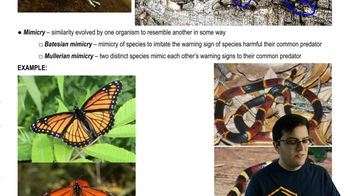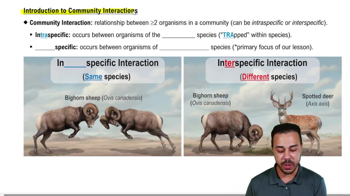Table of contents
- 1. Introduction to Biology2h 42m
- 2. Chemistry3h 40m
- 3. Water1h 26m
- 4. Biomolecules2h 23m
- 5. Cell Components2h 26m
- 6. The Membrane2h 31m
- 7. Energy and Metabolism2h 0m
- 8. Respiration2h 40m
- 9. Photosynthesis2h 49m
- 10. Cell Signaling59m
- 11. Cell Division2h 47m
- 12. Meiosis2h 0m
- 13. Mendelian Genetics4h 44m
- Introduction to Mendel's Experiments7m
- Genotype vs. Phenotype17m
- Punnett Squares13m
- Mendel's Experiments26m
- Mendel's Laws18m
- Monohybrid Crosses19m
- Test Crosses14m
- Dihybrid Crosses20m
- Punnett Square Probability26m
- Incomplete Dominance vs. Codominance20m
- Epistasis7m
- Non-Mendelian Genetics12m
- Pedigrees6m
- Autosomal Inheritance21m
- Sex-Linked Inheritance43m
- X-Inactivation9m
- 14. DNA Synthesis2h 27m
- 15. Gene Expression3h 20m
- 16. Regulation of Expression3h 31m
- Introduction to Regulation of Gene Expression13m
- Prokaryotic Gene Regulation via Operons27m
- The Lac Operon21m
- Glucose's Impact on Lac Operon25m
- The Trp Operon20m
- Review of the Lac Operon & Trp Operon11m
- Introduction to Eukaryotic Gene Regulation9m
- Eukaryotic Chromatin Modifications16m
- Eukaryotic Transcriptional Control22m
- Eukaryotic Post-Transcriptional Regulation28m
- Eukaryotic Post-Translational Regulation13m
- 17. Viruses37m
- 18. Biotechnology2h 58m
- 19. Genomics17m
- 20. Development1h 5m
- 21. Evolution3h 1m
- 22. Evolution of Populations3h 52m
- 23. Speciation1h 37m
- 24. History of Life on Earth2h 6m
- 25. Phylogeny2h 31m
- 26. Prokaryotes4h 59m
- 27. Protists1h 12m
- 28. Plants1h 22m
- 29. Fungi36m
- 30. Overview of Animals34m
- 31. Invertebrates1h 2m
- 32. Vertebrates50m
- 33. Plant Anatomy1h 3m
- 34. Vascular Plant Transport1h 2m
- 35. Soil37m
- 36. Plant Reproduction47m
- 37. Plant Sensation and Response1h 9m
- 38. Animal Form and Function1h 19m
- 39. Digestive System1h 10m
- 40. Circulatory System1h 57m
- 41. Immune System1h 12m
- 42. Osmoregulation and Excretion50m
- 43. Endocrine System1h 4m
- 44. Animal Reproduction1h 2m
- 45. Nervous System1h 55m
- 46. Sensory Systems46m
- 47. Muscle Systems23m
- 48. Ecology3h 11m
- Introduction to Ecology20m
- Biogeography14m
- Earth's Climate Patterns50m
- Introduction to Terrestrial Biomes10m
- Terrestrial Biomes: Near Equator13m
- Terrestrial Biomes: Temperate Regions10m
- Terrestrial Biomes: Northern Regions15m
- Introduction to Aquatic Biomes27m
- Freshwater Aquatic Biomes14m
- Marine Aquatic Biomes13m
- 49. Animal Behavior28m
- 50. Population Ecology3h 41m
- Introduction to Population Ecology28m
- Population Sampling Methods23m
- Life History12m
- Population Demography17m
- Factors Limiting Population Growth14m
- Introduction to Population Growth Models22m
- Linear Population Growth6m
- Exponential Population Growth29m
- Logistic Population Growth32m
- r/K Selection10m
- The Human Population22m
- 51. Community Ecology2h 46m
- Introduction to Community Ecology2m
- Introduction to Community Interactions9m
- Community Interactions: Competition (-/-)38m
- Community Interactions: Exploitation (+/-)23m
- Community Interactions: Mutualism (+/+) & Commensalism (+/0)9m
- Community Structure35m
- Community Dynamics26m
- Geographic Impact on Communities21m
- 52. Ecosystems2h 36m
- 53. Conservation Biology24m
51. Community Ecology
Introduction to Community Interactions
Problem 12a`
Textbook Question
The carnivorous plant Nepenthes bicalcarata ('fanged pitcher plant') has a unique relationship with a species of ant—Camponotus schmitzi ('diving ant'). The diving ants are not digested by the pitcher plants but instead live on the plants and consume nectar. Diving ants also dive into the digestive juices in the pitcher, swim to the bottom, and capture and consume trapped insects, leaving uneaten body parts and ant feces behind.
What nutritional impact do the ants have on fanged pitcher plants?
Do the pitcher plants derive any nutritional benefit from this relationship?
Researchers tested the hypothesis that the relationship between diving ants and pitcher plants is mutualistic (i.e., both species derive a nutritional benefit). To do so, they compared leaf surface area (as a measure of overall growth) in two sets of pitcher plants: plants with diving ants and plants without. The results are shown in the graph. The P values indicate whether there is a significant relationship between the size of the host plants and the surface area of the host plants' leaves. Based on this graph, what conclusions can be drawn about the impact of diving ants on overall plant growth?
 Verified step by step guidance
Verified step by step guidance1
Examine the graph provided in the problem, focusing on the comparison between pitcher plants with diving ants and those without. Look for differences in leaf surface area, which is used as a measure of overall growth.
Identify the P values associated with the data in the graph. P values help determine the statistical significance of the observed differences between the two sets of plants. A P value less than 0.05 typically indicates a significant difference.
Consider the hypothesis that the relationship between diving ants and pitcher plants is mutualistic. If the plants with ants show significantly greater leaf surface area compared to those without, it suggests that the ants contribute positively to plant growth.
Analyze the potential mechanisms by which diving ants could enhance plant growth. The ants may contribute nutrients through uneaten insect parts and ant feces, which could be absorbed by the plant, thus providing a nutritional benefit.
Draw conclusions based on the data and statistical analysis. If the P values indicate a significant difference in leaf surface area favoring plants with ants, it supports the hypothesis of a mutualistic relationship, where both the ants and the plants benefit nutritionally.
 Verified video answer for a similar problem:
Verified video answer for a similar problem:This video solution was recommended by our tutors as helpful for the problem above
Video duration:
2mPlay a video:
Was this helpful?
Key Concepts
Here are the essential concepts you must grasp in order to answer the question correctly.
Mutualistic Relationships
Mutualistic relationships are interactions between two species where both parties benefit. In the context of the fanged pitcher plant and diving ants, the ants provide nutrients through their waste and uneaten prey, while the plant offers a habitat and nectar. Understanding this concept helps explain how both organisms might gain nutritional advantages from their association.
Recommended video:
Guided course

Fungi - 1
Nutrient Acquisition in Carnivorous Plants
Carnivorous plants like Nepenthes bicalcarata obtain nutrients by trapping and digesting insects. This adaptation allows them to thrive in nutrient-poor environments. The presence of diving ants could enhance nutrient acquisition by breaking down prey and contributing additional nutrients through their waste, potentially impacting the plant's growth and health.
Recommended video:
Guided course

Soil Nutrients
Statistical Significance and P Values
P values in statistical analysis indicate the probability that observed differences are due to chance. A low P value suggests a significant difference between groups. In this study, comparing leaf surface area of plants with and without ants, a significant P value would support the hypothesis that ants positively affect plant growth, indicating a mutualistic relationship.
Recommended video:

Testing if a Population is in Hardy-Weinberg Equilibrium

 1:57m
1:57mWatch next
Master Introduction to Community Interactions with a bite sized video explanation from Jason
Start learningRelated Videos
Related Practice


















































